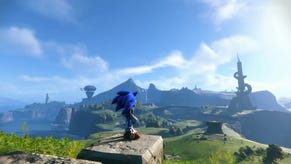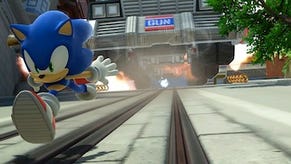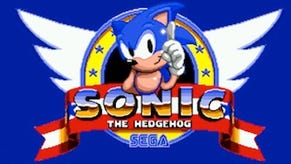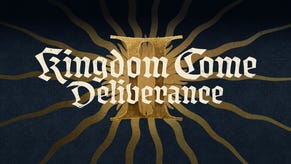Something old, something new: Sonic Generations
Very little borrowed, but something very blue - Alex Donaldson goes hands-on out the latest offering from the world's most rapid rodent.
Sega has a hell of a task laid out for it with Sonic the Hedgehog. Unlike Mario, Sega’s speedy blue mascot has spanned a bunch of different gameplay styles - there was the momentum-based platforming on the Mega Drive and strange open-world ‘Adventure stages’ on the Dreamcast, and to today’s youth Sonic is most synonymous with action-packed, speed-boost filled stages.
That leaves some – like folks from my generation – grumpy. We miss the times when speed was a reward for skilful play, and when slowing down revealed hidden nooks and crannies in levels – and until now Sega has had to target one audience or the other, leaving one chunk of its fanbase in the cold.
With Sonic Generations, though, it's trying to please both audiences at once. Classic Sonic will offer that 2D platforming, while Modern Sonic will offer the over-the-top speed-fest similar to recent titles. We dropped in to get some hands-on time and see a demo of the game from its producer, Takeshi Iizuka, during GamesCom 2011.
We’ll get the hard, core facts out of the way first. Sonic Generations is coming in two different configurations – a high definition version will ship on PC, PlayStation 3 and Xbox 360 with nine different environments - each with a Classic and Modern level spanning all the major Sonic releases. Here, Modern Sonic plays as he does in Sonic Colours, the most recent 3D release.
The 3DS version will offer 7 environments, each with Modern and Classic versions. One is the same as the HD version – Green Hill Zone – but the rest are different picks. Here both modes play in 2D, but Modern Sonic handles more as he’s played in the Sonic Rush titles on the DS, with boosts and more speed-focused gameplay.
Iizuka chooses to demo a never-before seen level, Rooftop Run. It’s the most modern level shown so far, from 2008’s Sonic Unleashed.
“The 2D version has been built from the ground up, but the 3D version is closer to the original Unleashed level,” Iizuka explains to us through a translator.
“So the 3D version gives you a very familiar experience while the 2D version gives you a completely different experience that takes place in the same theme.”
As the 2D version of the level begins it’s a weird mixture of old and new. Classic Sonic’s pudgy form and the 2D perspective feel distinctly 90s, but the enemies and realistic-looking environments are of course right out of Sonic Unleashed.
“As you can see in the background, this is basically Rooftop Run as fans will remember it to have been,” Iizuka adds, gesturing to key elements of the design.
“While it looks similar, the level design here is very much in line with the retro, old-school Sonic games – if you slow down there’s hidden areas to find and go in by doing things like going behind walls to find hidden item boxes and things. That really adds to the retro experience and will feel familiar to old fans.”
Another thing new to the Classic Sonic layout of the level is the addition of what Iizuka describes as a ‘Carnival style’ atmosphere to the level. Confetti flies about the level as Sonic speeds through, but this also allows a classic mechanic to return – Sonic can jump into balloons to pop them and get an extra boost to a jump in platforming sections, a mechanic first seen in Sonic 3 in 1994.
According to Iizuka, adding such platform elements is vital to the game’s Classic Sonic levels.
“This level in its original form was very much focused on speed. With classic Sonic, the focus is instead placed more on platforming. Speed is a reward rather than a given with classic Sonic – the whole game is built on this idea with classic Sonic.”
As Iizuka explains, Sonic suddenly dips down into a very different looking area of the level. No longer Rooftop Run in a literal sense, the level actually heads underground to an area with gigantic barrels and enemies aplenty. As it turns out, this level is based off another area of the game this level is pulled from.
“This area with the barrels is a newly added area to Rooftop Run for the classic Sonic section,” Iizuka says.
“In Unleashed this was an area that you were in when you were a werewolf – but we’ve incorporated this section into classic Sonic’s version of Rooftop Run for variety and as a nod to that part of Unleashed.”
In the underground we’re shown another important element of the classic Sonic gameplay – branching pathways. “The idea that there’s multiple routes you can take to get through a level is true to the originals,” Iizuka tells us.
In the section we see Sonic can either go up a higher, slower route and push a giant barrel off a ledge to crush the enemies below or go down below, which is faster, but risk fighting them yourself. Iizuka does the former, so we see the barrel used as a weapon to crush the enemies. This, too, is an example of the type of ideas they’re adding to classic Sonic’s levels.
“There are new gimmicks for the levels – small gameplay elements that were not in the original level but have been built in for the new perspective.” As well as barrels and balloons, there are basket-shaped swings that carry Sonic across large gaps in the level.
The finale of the classic Sonic version of the level sees Sonic involved in a little puzzle at a clock face. By climbing on the hands of the clock, the player has to guide Sonic to the very middle of the clock while avoiding enemies to trigger the finale of the level. Sadly, we never see it – our time is up and we have to see Modern Sonic in action.
If one thing is striking, it’s that the Modern Sonic level is over in around half the time the classic Sonic level is. A good part of that, Iizuka explains, is due to the sheer speed of Modern Sonic. “In Modern Sonic it really is non-stop, high-speed action – the emphasis really is on speed. For this level, it’s much closer to what this original game was, though still different.”
It’s high-speed running from a hybrid 2D-3D perspective that’s constantly moving, and is notably similar to Sonic Colours on the Wii. Quick Step returns, the mechanic that sees Sonic running from a third person perspective with the player using the shoulder buttons to shift him left and right to avoid obstacles rapidly approaching from the horizon.
While the gameplay is similar to Colours, tweaks and changes have been made to the mechanics to make it a bit friendlier than previous 3D Sonic entries. A big complaint, bottomless pits, has been addressed with some interesting signage placed before certain jumps and drops throughout the level which show the blue hedgehog plunging to his doom against a very noticeable red background.
"The level is designed in such a way with Modern Sonic where you can still branch – on top of the roof of buildings, below buildings, even inside buildings. There are places to go."
“At high speed it’s hard to tell which bits will kill you if you fall or jump down,” Iizuka notes, pointing out a nasty, death-dealing ledge. “We’ve tried to make that clearer to the user immediately as they fly through the levels what will kill them, so we’ve got this hazard symbols which will appear before dangerous jumps or drops.”
Modern Sonic’s journey through Rooftop Run is a blur of grind rails, motion blur and Sonic’s voice actor shouting out happily as he performs various manoeuvres, but Iizuka is keen to point out there is depth to modern Sonic’s levels.
“The level is designed in such a way with Modern Sonic where you can still branch – on top of the roof of buildings, below buildings, even inside buildings. There are places to go,” he says.
At the end of the level the clock tower makes another appearance, but in a very different way now. With Modern Sonic it’s more of a race to the top of the tower and right back down again. The level’s over in a few short minutes, finishing with a short mini-battle with an enemy airship which spits out rings as a reward for defeating it quickly.
With the demo over, Iizuka explains exactly why he thinks Sonic Generations is his team’s most challenging Sonic project to date. “The challenge we faced was that each level had its original that we were taking inspiration from.
“That original may have been a classic level with 2D side scrolling or of course it may have been a 3D level. We’ve had to recreate those levels in both 3D and 2D, and the challenge really was to keep to the original theme without breaking away from it too much while also giving completely original things to the user.”
When we get hands-on time with the game, the similarities in Sonic Colours in the 3D levels are absolutely clear. It controls and feels very much like the Wii release but now on a traditional controller and without the extra powers Sonic accrued in the game – but that’s no bad thing, as Sonic Colours was the best 3D Sonic title since the Dreamcast.
As a veteran of the Mega Drive classics I felt like classic Sonic’s controls needed tightening up a little – as exemplified by how many times Iizuka himself struggled with platforming in his demo – but the core mechanics and physics feel leaps and bounds ahead of Sonic the Hedgehog 4, Sega’s recent downloadable offering.
Interestingly, I found the classic Sonic physics and controls on the 3DS to be much closer to those I have fond memories of from the 90s. On the 3DS Sonic & Knuckles’ Mushroom Hill Zone is playable. Entire segments of the level are recognizable from my memory of the original layout in Classic Sonic’s run-through, and this feels much closer to a remake than a reimagining than any of the HD levels I’ve played so far.
I felt like classic Sonic’s controls needed tightening up a little – as exemplified by how many times Iizuka himself struggled with platforming in his demo.
After hands-on time Sonic Generations leaves the feeling of a lovingly created tribute to 20 years of the blue Hedgehog, and Iizuka is clearly keen to try to please as many of Sonic’s fans as possible, young and old with this new title. “The main take away we want people to have is that with Classic Sonic you can have real platform action while with Modern Sonic you can have non-stop fast-paced action,” he tells us after we try the game out.
“I hope that there will be something here for everybody.”
Sonic Generations is set to launch for the PlayStation 3, Xbox 360, PC and 3DS in November.















.jpg?width=291&height=164&fit=crop&quality=80&format=jpg&auto=webp)


